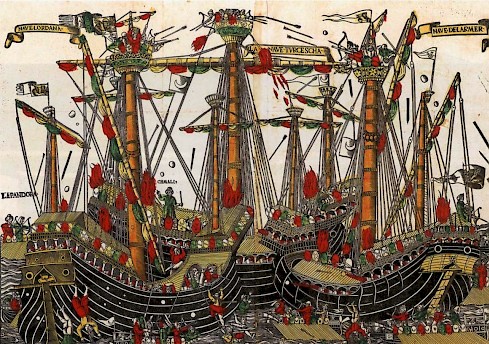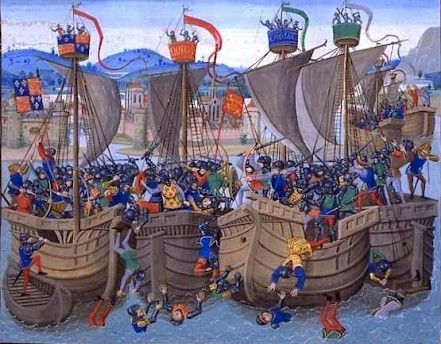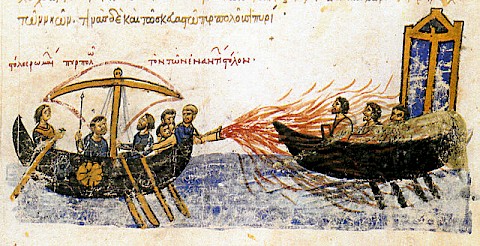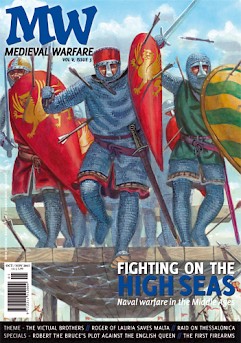Top Five Naval Battles of the Middle Ages
Here is our list of the five most important naval battles to take place in medieval Europe.
Battle of Zonchio (1499)

When Venice went to war against the Ottoman Empire in 1499, it was considered to be one of the naval powers of the Mediterranean. But their plan to send dozens of galleys and warships against a Turkish fleet stationed in the Ionian Sea would end as a fiasco. Antonio Grimani was chosen to command the Venetian fleet because of his wealth and political connections instead of his military abilities, and he proved to ineffective and indecisive. The clashes between the Venetians and Ottomans, which took place over four separate days in August of that year, saw the former side bedeviled by feuding captains and crews that lacked experience.
In her book Medieval Naval Warfare, 1000-1500, Susan Rose writes about one of the most of critical stages of the battle, when the Venetians were about to start an attack:
As the trumpeters sounded the advance, a squadron of light galleys joined Grimani’s force from Corfu led by Andrea Loredano who had the reputation of being a dashing and popular commander. His arrival was greeted with enthusiastic shouts of his name from the galleymen who seem to have had no very good opinion of Grimani. Loredano went to board the Pandora the largest of the Venetian round ships and with another commanded by Albano Armer attacked the largest Turkish ship believed to be commanded by Kemal Ali (or Camali to the Venetians), a notorious corsair long hunted unsuccessfully by the Venetian galley patrols. The three vessels became grappled together. A fire broke out on the Turkish ship which spread to the others and soon all were in flames.
The disaster was magnified by the lack of action by Grimani and the other commanders, who failed to enter the battle. They soon returned home in disgrace. Four years later the Venetians would seek peace with the Ottoman Empire, and give up several of its colonies. The Turkish victory in the war would propel them into being one of the dominant naval forces in the Mediterranean for most of the 16th century.
Battle of Sluys (1340)

One of the opening battles of the Hundred Years War, this naval fight involved at least 300 ships. King Edward III was on board one of the ships of the English fleet as the searched for their French enemies. After finding them at a point just off of what is now the Belgian-Dutch border, the two sides began the fighting on June 24, 1340.
The chronicler Jean Froissart described the scene:
Fierce fighting broke out on every side, archers and crossbowmen shooting arrows and bolts at each other pell-mell, and men-at-arms struggling and striking in hand-to-hand combat. In order to come to close quarters, they had great iron grappling-hooks fixed to chains, and these they hurled into each others’ ships to draw them together and hold them fast while the men engaged. Many deadly blows were struck and gallant deeds performed, ships and men were battered, captured and recaptured…. It was indeed a bloody and murderous battle. Sea-fights are always fiercer than fights on land, because retreat and flight are impossible. Every man is obliged to hazard his life and hope for success, relying on his own personal bravery and skill.
The battle ended with much of the French fleet destroyed or captured, while only two English ships were lost. Edward III’s triumph at Sluys would give him an early advantage in the Hundred Years War, setting up further victories on French soil.
Battle of Nicomedia Bay (718)

The Arab Siege of Constantinople in the years 717-718 was a critical event in the history of the Byzantine Empire. The forces of the Umayyad Caliphate attacked the city from both land and sea, including naval battles fought just outside Constantinople’s harbour. One of the key episodes of the siege took place in the spring of 718 when two fleets - one from Egypt and the other from North Africa - of a combined 760 vessels was sent to area to resupply the Arab armies. However, some of the Egyptian crew defected to the Byzantine side, revealing that the fleets were hiding in Nicomedia Bay in the eastern part of the Sea of Marmara.
The Chronographia of Theophanes’ Confessor explains what happened next:
When the emperor had been informed by them of two fleets hidden in the bay, he constructed fire-bearing siphons which he placed in dromones and biremes and sent these against the fleets. With God’s help, thanks to the intercession of the all-pure Theotokos, the enemy were sunk on the spot. Our men took the enemy’s supplies as booty and returned in joyous victory.
The loss of these supplies was an important factor in the Arab decision to give up the siege, which would mark an end to the Umayyad Caliphate’s attempts to conquer southeastern Europe.
With the outbreak of the War of the Sicilian Vespers in 1282, both the Angevins and the Aragonese sought to take control of the strategic Mediterranean island of Malta. The Crown of Aragon selected Roger of Lauria to command its fleet, and he would go on to win a string of naval victories against the Angevin Kingdom of Naples. His first took place in the Grand Harbour of Malta on July 8, 1283, where he captured 10 enemy ships, took 860 prisoners, and left 3,500 of his adversaries dead. William Welsh, in his article about the battle, explains, “Roger remained undefeated throughout his career because he maintained tight control over his vessels during combat, looked out for the welfare of his crews and varied his tactics so the the enemy was caught off balance. He emerged from the War of the Sicilian Vespers with a sterling reputation as an Admiral.”
Battle of Hafrsfjord (c.872)
Little is known about this naval battle - even the year it took place is debated by scholars - but it represents one of the most important points in Norwegian history. It was this battle where Harald Fairhair defeated a coalition of several petty kings and unified Norway under a single monarch. Most of the sources about the battle were written hundreds of years after it took place, but we do have this contemporary poem:
Did you hear in Hafrsfjord
how hard they fought
the high born king
against Kjotve the Rich.
ships came from the east
craving battle,
with gaping heads
and prows sculpted.
To learn more about naval warfare in the Middle Ages, please read Medieval Warfare magazine V:5 - Fighting on the High Seas.


